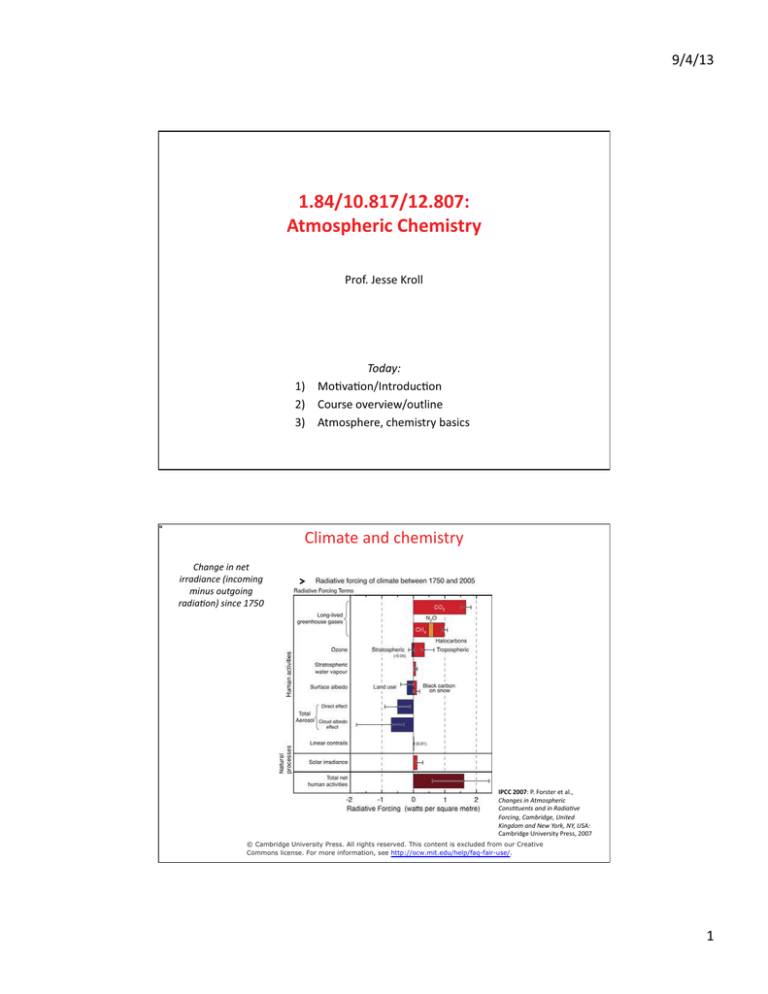
9/4/13 1.84/10.817/12.807:
Atmospheric Chemistry
Prof. Jesse Kroll
Today:
1) Motvaton/Introducton
2) Course overview/outline
3) Atmosphere, chemistry basics
Climate and chemistry
Change in net
irradiance (incoming
minus outgoing
radiaton) since 1750
IPCC 2007: P. Forster et al.,
Changes in Atmospheric
Consttuents and in Radiatve
Forcing, Cambridge, United
Kingdom and New York, NY, USA:
Cambridge University Press, 2007
© Cambridge University Press. All rights reserved. This content is excluded from our Creative
Commons license. For more information, see http://ocw.mit.edu/help/faq-fair-use/.
1
9/4/13
Climate and chemistry
Methane oxidaton forms water (CH4 + OH → CH3 + H2O) and eventually CO2; under polluted (high NOx) conditons, forms ozone as well
Nitrogen oxides form ozone
(warming), which in turn
increases oxidaton rates (more
OH), decreasing CH4 (cooling);
also forms nitrate aerosol
(cooling)
IPCC 2007: P. Forster et al.,
Changes in Atmospheric
Consttuents and in Radiatve
Forcing, Cambridge, United
Kingdom and New York, NY, USA:
Cambridge University Press, 2007
© Cambridge University Press. All rights reserved. This content is excluded from our Creative
Commons license. For more information, see http://ocw.mit.edu/help/faq-fair-use/.
Ozone depleton
Reprinted by permission from Macmillan Publishers Ltd: Nature.
Source: Nature 249: 810 - 812. © <1974>.
2
9/4/13 Ozone depleton
This image is in the public domain.
TOMS (Total Ozone Monitoring Satellite) Data
(global depleton occurring as well)
Ozone depleton: Montreal Protocol
This image is in the public domain.
This image is in the public domain.
WMO/UNEP, Scientfc Assessment o/ Ozone Depleton: 2006
3
9/4/13 Ecological health/biogeochemistry
This image is in the public domain.
This image is in the public domain.
acid depositon
nutrient depositon
wikipedia
Acid rain This image is in the public domain.
From D. Jacob
4
9/4/13 Human health Ozone
This image is in the public domain.
htp://www.epa.gov/o3healthtraining/
populaton.html
Partculate mater
© Massachusetts Medical Society. All rights reserved. This content
is excluded from our Creative Commons license. For more
information, see http://ocw.mit.edu/help/faq-fair-use/.
D. W. Dockery et al., N. Engl. J. Med. 329, 1753-1759 (1993)
Air polluton and health, 2010-2050
© Organisation for Economic Co-operation and Development (OECD) (Rights and
Permissions Unit). All rights reserved. This content is excluded from our Creative
Commons license. For more information, see http://ocw.mit.edu/help/faq-fair-use/.
OECD Environmental Outlook to 2050
5
9/4/13 Visibility
WHO Guideline: 50 μg/m3
averaged over 24 hrs
Images removed removed due to copyright restrictions.
htp://news.bbc.co.uk/2/hi/in pictures/7506925.stm
Key elements in the atmosphere
abundant
also important
less abundant (trace)
boring
.and many other trace elements
6
9/4/13 ncreasing due to human actvity
Chemical compositon of atmosphere
Chemical Species
Volume /racton, ppm
Nitrogen (N2)
Oxygen (O2)
Argon (Ar)
Carbon dioxide (CO2)
Neon (Ne)
Helium (He)
Methane (CH4)
Krypton (Kr)
Hydrogen (H2)
Nitrous oxide (N2O)
Carbon monoxide (CO)
Xenon (Xe)
Ozone (O3)
Nitrogen dioxide (NO2)
780,840 (78.084%)
209,460 (20.946%)
9,340 (0.9340%)
390 (0.039%)
1 .18 (0.001818%)
5.24 (0.000524%)
1.79 (0.000179%)
1.14 (0.000114%)
0.55 (0.000055%)
0.3 (0.00003%)
0.1 (0.00001%)
0.09 (0.000009%)
0.0 to 0.07 (0 to 0.000007%)
0.02 (0.000002%)
Not included in above dry atmosphere:
Water vapor (H2O) -0.40% over full atmosphere,
typically 1%-4% at surface
Atmospheric CO2
htp://en.wikipedia.org/wiki/Keeling curve
Image courtesy of Narayanese on Wikimedia. License: CC-BY-SA. This content is excluded fromour
Creative Commons license. For more information, see http://ocw.mit.edu/help/faq-fair-use/.
pre-industrial: -280 ppm
7
9/4/13 Chemical compositon of atmosphere
Chemical Species
Volume /racton, ppm
Nitrogen (N2)
Oxygen (O2)
Argon (Ar)
Carbon dioxide (CO2)
Neon (Ne)
Helium (He)
Methane (CH4)
Krypton (Kr)
Hydrogen (H2)
Nitrous oxide (N2O)
Carbon monoxide (CO)
Xenon (Xe)
Ozone (O3)
Nitrogen dioxide (NO2)
780,840 (78.084%)
209,460 (20.946%)
9,340 (0.9340%)
390 (0.039%)
18.18 (0.001818%)
5.24 (0.000524%)
1.79 (0.000179%)
1.14 (0.000114%)
0.55 (0.000055%)
0.3 (0.00003%)
0.1 (0.00001%)
0.09 (0.000009%)
0.0 to 0.07 (0 to 0.000007%)
0.02 (0.000002%)
Notes on units:
Not included in above dry atmosphere:
Water vapor (H2O) -0.40% over full atmosphere,
typically 1%-4% at surface
1) ppm, ppb, ppt refer to volume (ppmv,
ppbv, etc.)
2) For an ideal gas, PV=nRT, so volume
/racton and mole /racton are the same
3) These are mixing ratos, relatng
amount of the compound to the total
amount of air.
4) This is diferent from concentraton,
which is moles (or molecules) of
compound per absolute volume (usually
molecules/cm3).
5) Can convert between the two, but
the conversion depends on P, T
(alttude)!
{Standard" conditons for temperature and pressure
Courtesy of Wikepedia. License: CC-BY-SA. This content is excluded from our Creative
Commons license. For more information, see http://ocw.mit.edu/help/faq-fair-use/.
From htp://en.wikipedia.org/wiki/
StandardJconditonsJ/orJtemperatureJandJpressure
9/4/13 Oxidizing atmosphere
Oxygen has been called the {ultmate oxidant" 1
Accepts electrons readily (oxidaton state goes down)
Organic mater is the {ultmate reductant" 1
Donates electrons readily (oxidaton state goes up)
→ Organic carbon will be oxidized in the atmosphere
(ultmately end-product is CO2)
(.as will most other elements)
Morel and Hering, Principles and Applicatons o/
Aquatc Chemistry (Wiley, 1993)
1
Oxidaton: Thermodynamics
CH4 + 2O2 → CO2 + 2 H2O
molecule
ΔHf0 (kJ/mol)
S0 (J/mol/K)
CH4
-74.8
186.2
H 2O
-241.8
188.7
CO2
-393.5
213.6
O2
0.0
205.0
9
9/4/13 Thermodynamics vs. Kinetcs
Spontaneity of a reacton (thermodynamic favorability) tells us
almost nothing about the rate of a reacton (kinetc favorability)!
CH4 + 2O2
CO2 + 2H2O
© source unknown. All rights reserved. This content is excluded from our Creative
Commons license. For more information, see http://ocw.mit.edu/help/faq-fair-use/.
5/2 O2 + N2 + H2O → 2 HNO3
Image removed due to copyright restrictions.
See the book cover of Lewis, G. N., and M.
Randall, Thermodynamics and the Free Energy
of Chemical Substances for further details.
{We see from the large negatve free energy of
formaton of nitric acid that it should be
producible directly from its elements. Even
startng with water and air, we see by our
equaton that nitric acid should form untl it
reaches a concentraton of about 0.1 M where
the calculated equilibrium exists. It is to be
hoped that nature will not discover a catalyst
for this reacton, which would permit all the
oxygen and part of the nitrogen of the air to
turn the oceans into dilute nitric acid."
10
9/4/13 Free radicals
Chemical species that have an unpaired electron (unflled outer shell)
→ Very reactve, and drive most of atmospheric chemistry
H O
Hydroxyl radical (OH)
H O O
Hydroperoxy radical (HO2)
O N O
Nitrogen dioxide (NO2)
N O
Nitrogen oxide (NO)
What's next
11
9/4/13 Chemistry of the atmosphere
This image is in the public domain.
Strategic Plan for the U.S. Climate Change Science Program, 2006
12
0,72SHQ&RXUVH:DUH
KWWSRFZPLWHGX
---$WPRVSKHULF&KHPLVWU\
)DOO
)RULQIRUPDWLRQDERXWFLWLQJWKHVHPDWHULDOVRURXU7HUPVRI8VHYLVLWKWWSRFZPLWHGXWHUPV



